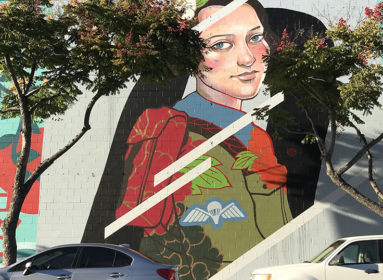Nadia Kalman was 4 when she emigrated from Kiev to Stamford in 1984 with her parents, Elena and Mikhail Kalman, and maternal grandparents, Lazar and Rachel Chalik.
A former teacher and assistant principal, the Brooklyn-based author now works as a writer-in-the-schools with the non-profit Teachers & Writers Collaborative in New York City. Kalman is a two-time writing fellow of the Fine Arts Work Center in Provincetown, Mass., whose stories have appeared in the Gettysburg Review, the Madison Review, the Antagonish Review, and publications including “Subtropics,” the Canadian magazine “The Walrus,” among others.
Her first novel, “The Cosmopolitans” (Livingston Press, 2010), won the Emerging Writer Award from “Moment” magazine and was a finalist for the Jewish Book Council’s Sami Rohr Prize in Jewish Literature. Nadia recently received a 2012 Literature Fellowship from the National Endowment for the Arts. Loosely based on Kalman’s own life, “The Cosmopolitans” follows the story of the Molochniks, a Russian-Jewish family who flees its homeland and ends up in Fairfield County, Conn.
Employed by Joseph Stalin during his violent anti-Zionist campaign, the euphemism “cosmopolitan” was used to attack Jewish intellectuals who were accused of being unpatriotic.
Kalman will talk about her work as part of “Award-Winning Jewish Fiction,” a three-author panel sponsored by the Mandell JCC of Greater Hartford Jewish Book Festival on Tuesday, Jan. 25. The panel also features Julie Orringer, author of “The Invisible Bridge,” and Austin Ratner, author of “The Jump Artist.”
Kalman spoke with the Ledger about the life experiences that influenced her book, “The Cosmopolitans.”
Q: Do you remember Jewish life in Kiev? What did your parents and grandparents tell you about their Jewish experience?
A: When we left Kiev, I was four years old. I don’t have many personal memories of Jewish life there, but I know that my father was secretly studying Hebrew when we left; that my great-uncle was secretly circumcised during the Stalinist era – which was very risky for everyone involved, not least the great-uncle – and that my great-grandmother somehow managed to secretly procure Passover matzo. The common element, of course, is secrecy. It seemed nothing would ever change there. My parents wanted me and their future children to have more choices and to not feel the same fear they felt.
Q: What was your family’s Jewish life like in Stamford?
A: When we arrived in the United States, my family had little money, even though my mother had been an architect and my father had been an engineer in the Soviet Union. Jewish families were only allowed to take limited funds when they left the country; in 1984, that was $60. We were sponsored by Jewish Family Services of Greater Hartford. We received three months of living expenses, which we later repaid, and furniture. Later, we were also able to make contributions to the Jewish Federation of Greater Hartford. I have a younger brother, Lev, who is a filmmaker and who lives in Brooklyn. My parents still live in Stamford, as does my grandmother, who recently moved there from West Hartford.
My parents and their friends, who are also Jews from the FSU, take part in a weekly Torah study group, followed by dinner at one of their houses.
Q: How and why did you become a writer?
A: The first book I ever wrote was a series of alphabet poems intended to help my grandmother learn English. Since three-quarters of the poems involved horses, I’m not sure how useful they might have been to an engineer living in Hartford. My elementary school in Stamford owned two films which were shown whenever a teacher was absent: “West Side Story” and “Fiddler on the Roof.” The repeated watching of those films had an interesting effect on my
romantic expectations, and, later, on some of the questions I wrestled with in writing my first novel. As I wrote, I wondered, what constitutes a “good match”? What do we leave behind when we travel to a new place, and which traditions follow us? Can people from different backgrounds ever truly understand each other? Is it even possible for us to understand those closest to us?
In ‘Fiddler on the Roof,” it really struck me how the characters thought everything would be okay, regardless of their current situation. As an immigrant from that part of the world, it seemed to reflect how people saw us as immigrants. When we came over, people seemed to think we came from a shtetl. That always seemed interesting to me.
Q: What specifically inspired you to start writing “The Cosmopolitans?”
A: In the Soviet Union, “cosmopolitan” is a word for someone who had no true home or loyalty. In America, people think of the ladies’ magazine or the fancy drink. The Russian immigrants in the book try to escape from history by coming to the United States, but their lives are bound by the past. The novel is fictional, but my family shared many of the same experiences of its characters. Like the Molochniks in the book, my family also endured state-sponsored anti-Semitism: arrests, detentions, and murders in my grandparents’ generation, and the denial of education and jobs in my parents’ generation. I wrote the book really quickly over the course of about a year. Of course, when you’re writing five pages a day, there are a lot of things wrong with those five pages. I ended up going through 52 drafts of the book I think that the characters wish were they cosmopolitans or citizens of the world, but it doesn’t always work out that way. I also thought it was funny that the name of this antisemitic program is also the name a popular drink in the U.S. The title of the book is ironic because no one feels at home in the world. If we all realize that we’re all newcomers, in a way, to the world, and there’s always going to be something we don’t understand about it or other people, we can be better prepared to accept each other.
For more information about “Award-Winning Jewish Fiction:(860) 236-4571 / www.mandelljcc.org.








 Southern New England Jewish Ledger
Southern New England Jewish Ledger










